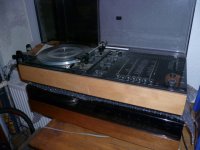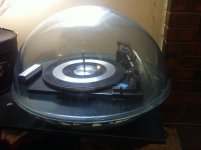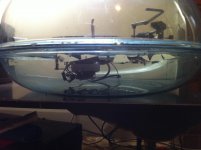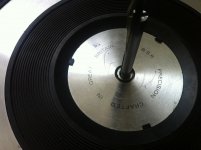Hi all,
Hoping for some advice on restoring my Dad's old plastic bubble turntable. I would like to make it sound as good as possible (obviously!). As it is a hollow bubble it will be hard to get it to sound dead, so I am after some tips on how to get the best result.
Here are the initial thoughts that I have had
I am a novice so the learning curve is going to be steep. Any tips would be greatly appreciated.
Thanks all,
Paul.
Hoping for some advice on restoring my Dad's old plastic bubble turntable. I would like to make it sound as good as possible (obviously!). As it is a hollow bubble it will be hard to get it to sound dead, so I am after some tips on how to get the best result.
Here are the initial thoughts that I have had
- Replace steel platter with wood
- Keep turntable
- Remove auto return
- Replace speed switches/on off switches
- Add new tone arm
- Replace spindle
- Figure out a way to dampen vibrations without changing the aesthetics too much.
I am a novice so the learning curve is going to be steep. Any tips would be greatly appreciated.
Thanks all,
Paul.
Attachments
Hi,
Yes its a very steep learning curve, and the simple fact is the BSR is ancient,
and is not probably worth any effort to modify / improve it to any extent,
though it appears to be one of their best decent multistackers models.
The deck is best refurbished /serviced with no mods as best as possible.
rgds, sreten.
Yes its a very steep learning curve, and the simple fact is the BSR is ancient,
and is not probably worth any effort to modify / improve it to any extent,
though it appears to be one of their best decent multistackers models.
The deck is best refurbished /serviced with no mods as best as possible.
rgds, sreten.
Last edited:
Paul,
sreten is awfully blunt... geez.
But, yes, that BSR isn't worth doing any work on.
In fact it may actually damage LPs.
What your dad had is a neat idea to put a cool dust cover on the TT.
If you really like that look, and then to honor your dad, I'd consider putting a good but inexpensive TT in that spot. Assuming, of course, you want to use/preserve the plastic bubble part.
I would think that he would want (or would have wanted) a better TT by now...
_-_-bear
sreten is awfully blunt... geez.
But, yes, that BSR isn't worth doing any work on.
In fact it may actually damage LPs.
What your dad had is a neat idea to put a cool dust cover on the TT.
If you really like that look, and then to honor your dad, I'd consider putting a good but inexpensive TT in that spot. Assuming, of course, you want to use/preserve the plastic bubble part.
I would think that he would want (or would have wanted) a better TT by now...
_-_-bear
Last edited:
This unit is what we would call a "record player" rather than a turntable.
If you want something nice, find a nice real turntable and mount it in the bubble enclosure.
Hmmm, that came off sounding kinda snooty, I don't mean it that way.
If you want something nice, find a nice real turntable and mount it in the bubble enclosure.
Hmmm, that came off sounding kinda snooty, I don't mean it that way.
Thanks for the pointers above, I had suspected that I would need to replace the lot.
Given that, I have a couple more questions if you don't mind.
It would be far easier for me to buy a turntable and mount it in the bubble enclosure - are there any commercially available turntables with the dimensions of the BSR - 33cm x 28cm - most seem to be around 42cm x 30cm. Would you recommend that I got something larger and cut it down to size, or try to find one the right size?
New or vintage?
Any ideas on how to mount the turntable? The base is made from plastic that is about 5mm thick. Would you recommend a perspex plinth of some sort in the base which provided a more solid foundation?
Thanks again for the suggestions,
Cheers,
Paul
Given that, I have a couple more questions if you don't mind.
It would be far easier for me to buy a turntable and mount it in the bubble enclosure - are there any commercially available turntables with the dimensions of the BSR - 33cm x 28cm - most seem to be around 42cm x 30cm. Would you recommend that I got something larger and cut it down to size, or try to find one the right size?
New or vintage?
Any ideas on how to mount the turntable? The base is made from plastic that is about 5mm thick. Would you recommend a perspex plinth of some sort in the base which provided a more solid foundation?
Thanks again for the suggestions,
Cheers,
Paul
Enzo, what is the difference between a turntable and a record player? Just for the ignorant german guy who can do nothing but feed these words into dict.leo.org and see what comes out.
That is what we say around here, here being my shop, not an official industry term.
The idea I have in mind is that "record player" generally connotes a thing that you can stack a few records on, it will drop one, play it, reject itself at the end, switch the tone arm out of the way, drop another record, and continue. They are generally pretty low performance, not a lot of balance and adjustment on the tone arm, an idler wheel drive on most with a low mass stamped platter. Often they are part of some greater system, such as one of those pieces of furniture with the record player and an AM/FM radio.
I have a couple nice enough turntables in my home system, and I might refer to them as my record player to be cute, but I reserve the term "turntable" for an independent component, usually of better quality and performance than the cheap consumer record player. Of course there is overlap, but many turntables are not automated, you have to pay attention at the end of the record. The platter tends to be more massive, acting like a flywheel for steadier speed. SOme are even servo driven or other direct drive, others are belt driven. Not likely to see idler wheel drive in a good table. The tone arm may even be a separate piece of gear, or at least a more precision piece of engineering than the simple hinge and pivot of the record player tone arm.
But those are just rules of thumb, and only in my mind, so others may not like the distinction I make.
The idea I have in mind is that "record player" generally connotes a thing that you can stack a few records on, it will drop one, play it, reject itself at the end, switch the tone arm out of the way, drop another record, and continue. They are generally pretty low performance, not a lot of balance and adjustment on the tone arm, an idler wheel drive on most with a low mass stamped platter. Often they are part of some greater system, such as one of those pieces of furniture with the record player and an AM/FM radio.
I have a couple nice enough turntables in my home system, and I might refer to them as my record player to be cute, but I reserve the term "turntable" for an independent component, usually of better quality and performance than the cheap consumer record player. Of course there is overlap, but many turntables are not automated, you have to pay attention at the end of the record. The platter tends to be more massive, acting like a flywheel for steadier speed. SOme are even servo driven or other direct drive, others are belt driven. Not likely to see idler wheel drive in a good table. The tone arm may even be a separate piece of gear, or at least a more precision piece of engineering than the simple hinge and pivot of the record player tone arm.
But those are just rules of thumb, and only in my mind, so others may not like the distinction I make.
A "record player" includes the amplifier and speakers. I'd call this a "record changer" since it "changes" stacked records. Record players are all-in-one devices, with the amplifier and possibly a speaker(s) as part of the case the record changer is mounted on/in.
Dual made record changers, but they cost enough and worked well enough that people called them [automatic] turntables. It also helped that many people used them exclusively in single-play mode instead of as changers.
Dual made record changers, but they cost enough and worked well enough that people called them [automatic] turntables. It also helped that many people used them exclusively in single-play mode instead of as changers.
Dual, yes. I have two old (1970 - 1973) Wega hifi sets, a Wega 3212 with a Dual 1216 and a Wega 3213 with a Dual 1218. These were probably the best purely mechanical turntables|record players|record changers they ever made. Lets see if i get them working again, but the stick for the record changing mechanism has been lost anyway.
Thänx for the explanations,
yai

Thänx for the explanations,
yai

- Status
- Not open for further replies.
- Home
- Design & Build
- Construction Tips
- Restoring a bubble turntable


